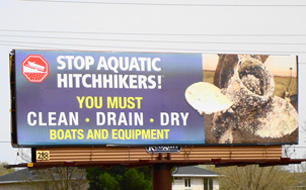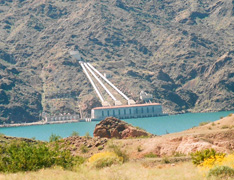Invasive quagga mussels found in two Utah reservoirs
Utah Division of Wildlife Resources implements a plan to cope with the water clogging organism
LeRoy W. Hooton, Jr.
March 23, 2009
Billboard sign located on I-15 entering Utah from the south end of St. George.

(St. George, UT) Utah has put out “unwelcome” billboard signs for the newest threat to the state’s water, the invasive quagga mussel. That’s what attendees to the Annual Utah Water Users Workshop heard from the Utah Division of Wildlife Resources Aquatic Invasive Species Coordinator Larry B. Dalton. The small clam-like quagga mussel appeared in the West just over 2 years ago – and “it’s on the move,” said Dalton. “Once you get them they never go away. Our goal is to contain them and not let them spread to other lakes and reservoirs.” The fresh water bivalve mollusk has been around for about 25 years in the eastern part of the U. S., arriving in the Great Lakes in northern America from Europe and Asia via trans-ocean contaminated ships. In the U. S., the organisms are transported from one unconnected body of water to another by contaminated boats and fishermen's boots.
First found in Lake Mead, today the entire Lower Colorado River system is infested. In 2007, the Colorado River Aqueduct was shut down to dry out 63 miles of open aqueduct to eliminate quagga larvae from spreading the organism into other system reservoirs. California has found the quagga in 19 of its water bodies. Likewise, it has been found in the Central Arizona Aqueduct.
Utah is not exempt from the infestation. According to Dalton, the quagga has been found in two Utah lakes – Electric Lake in Emery County and Red Fleet Lake located in northeastern Utah just north of the city of Vernal. Thirty-eight lakes and reservoirs were tested.
Measuring about ¾ of an inch across when fully grown, the quagga attaches itself to hard surfaces in enormous numbers (700,000 quagga mussels/square meter have been observed in the Great Lakes), plugging off the flow of water through power generating facilities, water treatment plant appurtenances, irrigation conveyance systems and other water-use related industries.
The state estimates a cost of $15 million per year to control the effects of the quagga on the state's 1,100 miles of water pipelines and 4,500 miles of canals. In the second driest state, delivering the full amount of water to farms and cities is critical to the state's economy.
Also, there is concerned about the quagga’s impact on the state’s fish and wildlife business, which annually generates $750 million of economic activity. Clustering quaggas set up the right conditions for blue-green algae that affects fisheries, resulting in the reduction of size and weight of sport fish. “This diminishes the quality of the fishing experience,” said Dalton.
In 2008, the state legislature appropriated $1.4 million to combat the infestation of the aquatic invasive species. On August 28, 2008 the Utah Wildlife Board adopted the “Utah Aquatic Invasive Species Management Plan” to cope with the threat and empower the Utah Division of Wildlife Resources (DWR) to deal with the problem. The plan is currently under review by the U. S. Fish and
|
During the past year, DWR has implemented an information program to inform the public of the problem and measures that boat owners can take to prevent the spread of quaggas to other state lakes and reservoirs.
Boat owners are now required to certify that their boats are free of quaggas or have the DWR or a professional decontaminate their boats. Last year DWR decontaminated 800 boats by applying 140 degree Fahrenheit water to wash the boat and trailer and to flush the boat motor, bilge and livewells. Water at this temperature will kill the organism. Self certification requires removal of all plants, fish, mussels and mud; then draining all water from the bilge, livewells and motor. The boat must dry for 7 days in the summer and 18 days during the spring and fall months before using.
Although Wyoming and Idaho have not reported infestations, it is hoped that quaggas will not spread to other water sources in the Upper Colorado Basin and Utah. Along the Wasatch Front there are many reservoirs that allow motorized boats for recreation and fishing. These reservoirs generate electrical power and deliver irrigation and municipal water to a large segment of the state's population. It is hoped that with the efforts of DWR and the cooperation of the recreation community, the quagga will not spread to other state lakes and reservoirs with the attending consequences to Utah’s water facilities, fisheries and recreation areas.
The Utah Aquatic Invasive Species Management Plan can be viewed at:
www.wildlife.utah.gov/invasivespecies/aisplan
